
Wolf spiders are members of the family Lycosidae. They are robust and agile hunters with excellent eyesight. They live mostly in solitude, hunt alone, and usually do not spin webs. Some are opportunistic hunters, pouncing upon prey as they find it or chasing it over short distances; others wait for passing prey in or near the mouth of a burrow.

Ctenizidae is a small family of mygalomorph spiders that construct burrows with a cork-like trapdoor made of soil, vegetation, and silk. They may be called trapdoor spiders, as are other, similar species, such as those of the families Liphistiidae, Barychelidae, and Cyrtaucheniidae, and some species in the Idiopidae and Nemesiidae. The name comes from the distinctive behavior of the spiders to construct trapdoors, and ambush prey from beneath them.

Deinopidae, also known as net casting spiders, is a family of cribellate spiders first described by Carl Ludwig Koch in 1850. It consists of stick-like elongated spiders that catch prey by stretching a web across their front legs before propelling themselves forward. These unusual webs will stretch two or three times their relaxed size, entangling any prey that touch them. The posterior median eyes have excellent night vision, allowing them to cast nets accurately in low-light conditions. These eyes are larger than the others, and sometimes makes these spiders appear to only have two eyes. Ogre-faced spiders (Deinopis) are the best known genus in this family. The name refers to the perceived physical similarity to the mythological creature of the same name. This family also includes the humped-back spiders (Menneus).

The deepwater sicklefin houndshark or the darksnout houndshark, is a houndshark of the family Triakidae. It is found in the western central Pacific, in the Coral Sea off Queensland and in the waters off New Caledonia.
Gastrotheca abdita is a species of frog in the family Hemiphractidae. It is endemic to Peru and only known from the Cordillera Colán in the Amazonas Region. The specific name abdita is Latin for "exiled" or "removed" and refers to the geographic isolation of the Cordillera Colán. Common name Cordillera Colan marsupial frog has been coined for it.

Trochosa ruricola is a wolf spider whose common name is rustic wolf spider. The females are 15 mm (0.6 in) but can reach 25 mm (1.0 in), and the males are 10 mm (0.4 in). Both sexes are dark brown and have a pale band that runs down to the carapace and continues to the abdomen.
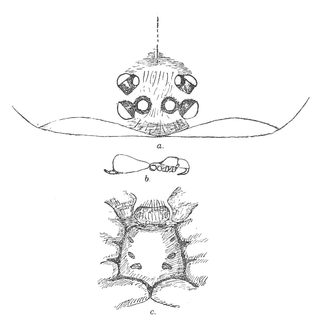
Cantuaria is a genus of South Pacific armored trapdoor spiders that was first described by Henry Roughton Hogg in 1902. From 1985 to 2006 it was merged with former genus Misgolas, now Arbanitis.
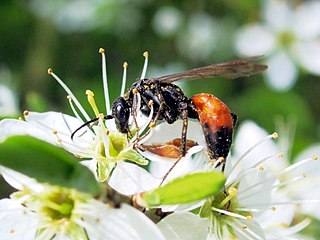
Priocnemis perturbator is a relatively large species of spider wasp which is quite common in Europe. It was previously considered to be the same species as the closely related P. susterai which were lumped as P. fuscus and this means that some early observations of behaviour are not applicable to either species. Even now the two species need close observation under a microscope or hand lens to distinguish them from each other.
Trochosa hungarica is a wolf spider species in the genus Trochosa found in Hungary.

Trochosa robusta is a wolf spider species with a Palearctic distribution, ranging from western Europe to Japan. In Europe, it is common north to Germany and Poland, and it also occurs in the Baltic countries and in England. The spiderlings can spread by ballooning and it has only recently established itself in Denmark where first observed in 2015 and restricted to south-facing slopes on the island of Bornholm. This heat-loving species is not known from elsewhere in the Nordic countries, but it is expected that it may spread further with increasing temperatures.
Psychotria abdita is a plant species in the family Rubiaceae and the genus Psychotria. The species is endemic to Peru, and the species was identified by Paul Carpenter Standley in 1929.
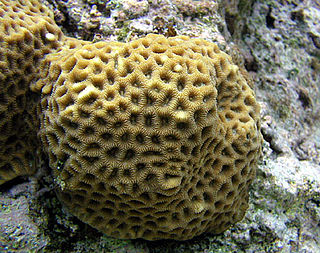
Favites abdita, also known as the larger star coral, is a species of stony coral in the family Merulinidae. It is native to the Indo-Pacific region and its range extends from East Africa and the Red Sea through the Indian Ocean to the Western Pacific Ocean. The International Union for Conservation of Nature has rated its conservation status as being "near-threatened".

Trochosa terricola is known as the ground wolf spider, is a wolf spider which is common and widespread in western and central Europe. It has been recorded as prey for the pompilid wasp.
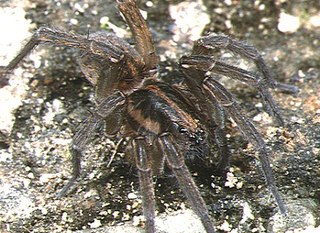
Trochosa aquatica is a species of wolf spider found in eastern Asia which was first described in 1985.
Trochosa spinipalpis is a specialised species of Palearctic, wolf spider which is restricted to bogs and other wetlands.
Paracyphononyx is a genus of spider wasps distributed in the tropics and warmer temperate regions; they differ from other pompilids in that they do not permanently disable the host spider but allow the spider to resume activity after the wasp has laid its egg on the spider while the wasp larva exists as koinobiont ectoparasitoid of the spider.
Litopyllus temporarius is a spider in the family Gnaphosidae, in the infraorder Araneomorphae . It is found in the USA.
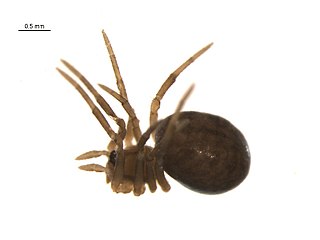
Enoplognatha intrepida is a spider in the family Theridiidae, in the infraorder Araneomorphae . The distribution range of Enoplognatha intrepida includes the USA, Canada, Greenland, and Korea.

Trochosa sepulchralis is a species of wolf spider in the family Lycosidae. It is found in the United States.












